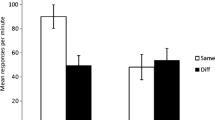Abstract
The role of Pavlovian contingencies in human skilled motor behavior was investigated in three experiments by means of a new conditioning preparation. In Experiment 1 the present method was shown to be appropriate for the study of associative learning. Subjects who experienced a standard delay configuration performed significantly more conditioned responses than subjects who received either backward conditioning or random pairings. Stimulus generalization was shown to be slight in two additional groups. Subsequent experiments examined conditioning with multiple conditioned stimuli (CSs). In particular, in Experiment 2 some reciprocal overshadowing was demonstrated when two conditional stimuli (tone and vibration) were compounded. Experiment 3 investigated blocking. Blocking was less than expected, however. Subjects’ perceptions of the stimuli and reaction time data suggest that a certain proportion had shifted their attention to the added element of the CS compound. Results are discussed in relation to other studies on Pavlovian learning in humans and animals, which are concerned with “stimulus selection.”
Similar content being viewed by others
References
Baer, P.E., & Fuhrer, M.J. (1969). Cognitive factors in differential conditioning of the GSR: Use of a reaction time task as the UCS with normals and schizophrenics.Journal of Abnormal Psychology, 74, 544–552.
Blanchard, R., & Honig, W.K. (1976). Surprise value of food determines its effectiveness as a reinforcer.Journal of Experimental Psychology: Animal Behavior Processes, (2), 67–74.
Bond, N.W. (1983). Reciprocal overshadowing in flavour-aversion learning.Quarterly Journal of Experimental Psychology, 35(B), 265–274.
Davey, G.C.L. (1987). An integration of human and animal models of Pavlovian conditioning: Associations, cognitions, and attributions. In G. Davey (Ed.),Cognitive processes and pavlovian conditioning in humans (pp. 83–114). Chichester: Wiley.
Dawson, M.E., & Schell, A.M. (1987). Human autonomic and skeletal classical conditioning: The role of conscious factors. In G. Davey (Ed.),Cognitive processes and pavlovian conditioning in humans (pp. 27–55). Chichester: Wiley.
Dmitriev, A.S. (1962). On a motor technique with verbal reinforcement.Soviet Psychology and Psychiatry, 1, 8–15.
Feldman, J.M. (1971). Added cue control as a function of reinforcement predictability.Journal of Experimental Psychology, 91, 318–325.
Fleiss, J.L. (1981).Statistical methods for rates and proportions. New York: Wiley.
Furedy, J.J. (1991). Some recalcitrant views on the role of non-cognitive S-R factors in human autonomic conditioning.Integrative Physiological and Behavioral Science, 26(1), 21–25.
Gormezano, I., & Kehoe, E.J. (1975). Classical conditioning: Some methodological-conceptual issues. In W.K. Estes (Ed.),Handbook of learning and cognitive processes, Vol. 2 (pp. 143–179). New York: Lawrence Erlbaum.
Hull, C.L. (1943).Principles of behavior. New York: Appleton.
Ivanov-Smolenski, A.G. (1927). On the methods of examining the conditioned food reflexes in children and in mental disorders.Brain, 50, 138–151.
James, J.H., & Wagner, A.R. (1980). One-trial overshadowing: Evidence of distributive processing.Journal of Experimental Psychology: Animal Behavior Processes, 6(2), 183–205.
Kamin, L.J. (1968). “Attention-like” processes in classical conditioning. In M.R. Jones (Ed.),Miami Symposion on the prediction of behavior: Aversive stimulation (pp. 9–33). Miami: University of Miami Press.
Kaufman, M.A., & Bolles, R.C. (1981). A nonassociative aspect of overshadowing.Bulletin of the Psychonomic Society, 18(b), 318–320.
Lipp, O.V., & Vaitl, D. (1988). Reaction time task as unconditioned stimulus: On conditioning skin conductance responses and heart rate using a nonaversive unconditional stimulus.Pavlovian Journal of Biological Science, 23, 165–172
Lovibond, P.F., Siddle, D.A.T., & Bond, N. (1988). Insensitivity to stimulus validity in human Pavlovian conditioning.Quarterly Journal of Experimental Psychology, 40B(4), 377–410.
Mackintosh, N.J. (1975). A theory of attention: Variations in the associability of stimuli with reinforcement.Psychological Review, 82, 276–298.
Martin, I., & Levey, A.B. (1987). Learning what will happen next: Conditioning, evaluation, and cognitive processes. In G. Davey (Ed.),Cognitive processes and pavlovian conditioning in humans (pp. 57–82). Chichester: Wiley.
Martin, I., & Levey, A.B. (1991). Blocking observed in human subjects.Quarterly Journal of Experimental Psychology, 43B(3), 233–256.
Mis, F.W., & Moore, J.W. (1973). Effects of preacquisition UCS exposure on classical conditioning of the rabbits’ nictitating membrane response.Learning and Motivation, 4, 108–114.
Papini, M.R., & Bitterman, M.E. (1990). The role of contingency in classical conditioning.Psychological Review, 97(3), 396–403.
Pavlov, I.P. (1927).Conditioned reflexes. Oxford: Oxford University Press.
Rescorla, R.A., & Wagner, A.R. (1972). A theory of Pavlovian conditioning: Variations in the effectiveness of reinforcement and nonreinforcement. In A.H. Black & B.F. Prokasy (Eds.),Classical conditioning, Vol. 2 (pp. 64–99). New York: Appleton-Century-Crofts.
Spence, K.W. (1966). Cognitive and drive factors in the extinction of the conditioned eyelid response in human subjects.Psychological Review, 73, 445–458.
Staddon, J.E.R. (1983).Adaptive behavior and learning. Cambridge: Cambridge University Press.
Tomie, A. (1980). Effects of unpredictable food upon the subsequent acquisition of autoshaping: Analysis of the context blocking hypothesis. In C.M. Locurto, H.S. Terrace, & J. Gibbon (Eds.),Autoshaping and conditioning theory (pp. 181–215). New York: Academic Press.
Trabasso, T., & Bower, G.H. (1968).Attention and Learning. New York: Wiley.
Author information
Authors and Affiliations
Rights and permissions
About this article
Cite this article
Rübeling, H. Pavlovian conditioning in human skilled motor behavior. Integrative Physiological and Behavioral Science 28, 29–45 (1993). https://doi.org/10.1007/BF02691198
Issue Date:
DOI: https://doi.org/10.1007/BF02691198




